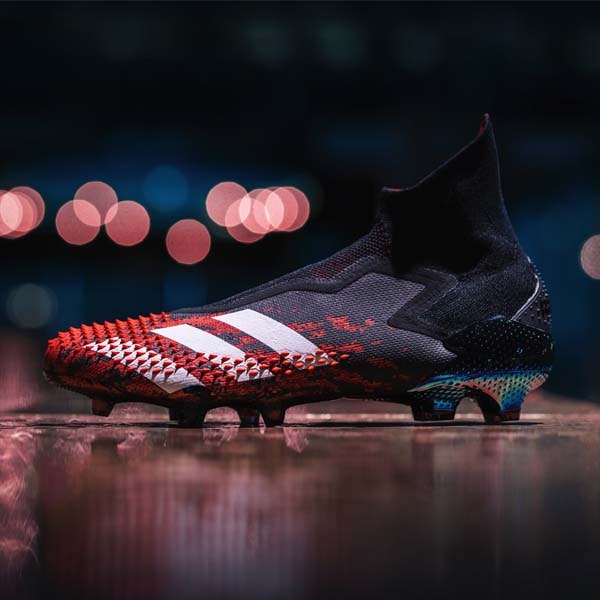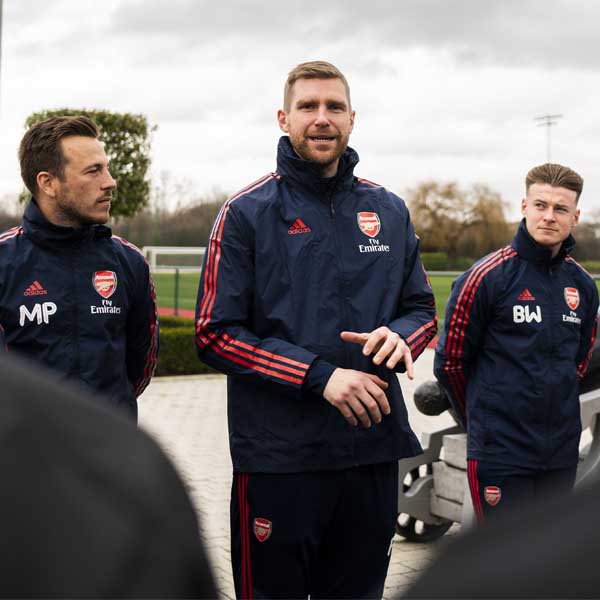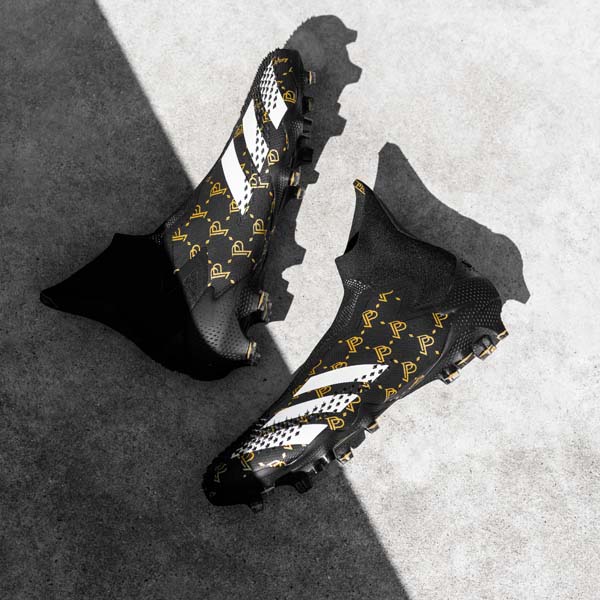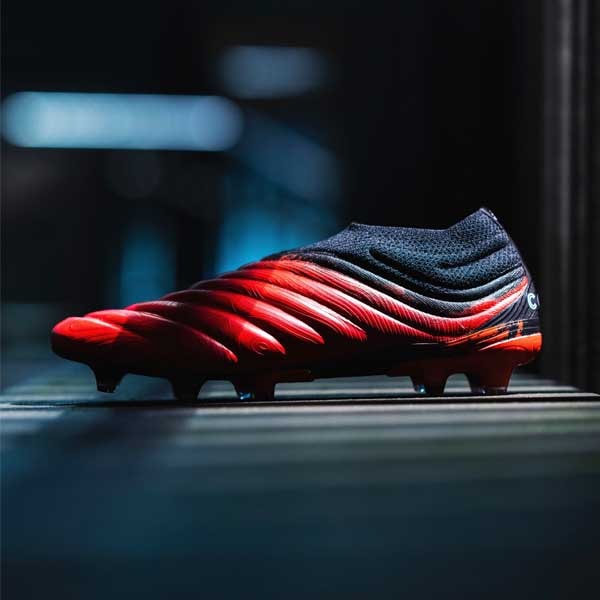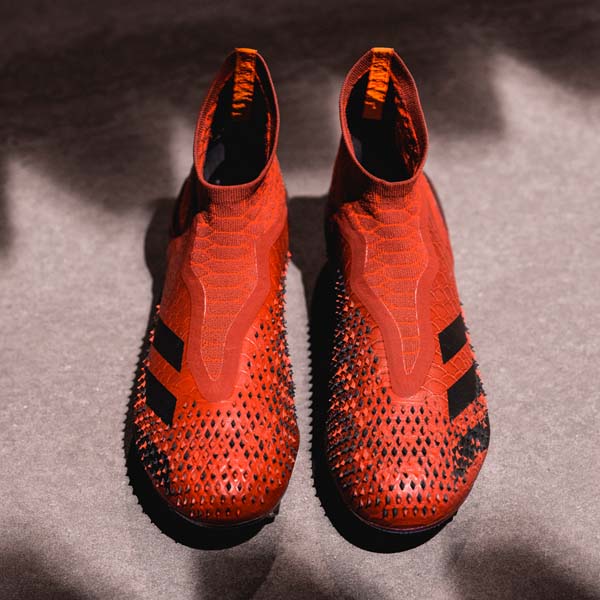After weeks of teasing, the Predator 20+ Mutator has finally arrived, and with it came the return of rubber in what is a demonic reimagining of the classic silo. But as one of the most iconic boots of all time, what’s the thought process behind its recreation? That’s what we wanted to find out when we sat down with adidas Football Design Director Ben Herath.
We were invited along to Arsenal’s Academy for the Predator 20 launch event, where we got to experience the new generation of Predator for ourselves; 406 swerve inducing rubber spikes boosting control and adding an unparalleled level of aggression to the aesthetics. While at the event we got the chance to sit down with Ben Herath, Football Design Director at adidas, and we took the opportunity to travel back to the start of the Predator timeline with him to understand the innovative technology that has gone into the creation of this latest chapter.
The Predator 20 feels like quite a dramatic departure from the previous generation. It almost feels like this is the real Predator comeback. How would you describe it?
That’s an interesting way of saying it! There have been two areas of inspiration on this one: the first is the incredible history and legacy that the Predator has, and we really wanted a new boot that was worthy of that legacy, but actually built for today’s players with today’s technologies in a modern way.
So it was important for us firstly to look at the inspiration of the Predator timeline and everything that came before while thinking about what the right elements and benefits from the past there were that could be modernised for the future. And at the same point, whether it’s a provocative design or a confident design, it’s always been about thinking bold. That’s wrapped up in the spirit of a Predator. We wanted to be bold in our design decisions here as well.
We took the Predator 18 as a starting point and we thought about how we could infuse it with real DNA from the Predator. For us that was always where it started. So it was a question of how do we bring more of that personality, performance, the innovation, the spirit of the Predator into the new design.
We took the Predator 18 as a starting point and we thought about how we could infuse it with real DNA from the Predator. It was a question of how do we bring more of that personality, performance, innovation, and spirit of the Predator into the new design"
When adidas brought the Predator back were you instantly thinking of the second and third generations?
Well as designers, we’re often working in the future. We create these things that we believe in, but we’re not quite sure how we’re going to make it. As we create a Predator we think sometimes that we push too far, and sometimes we have to take a step back and think about how we create this dream, how do we bring it to reality.
Is reverting to a name such as Mania, Accelerator, Powerswerve etc – in this case Mutator – as opposed to a number something that you’ve consciously brought back then?
Absolutely it is. We didn’t want anything that was technical or dry. We wanted to give this a name again, a character, a personality. It was really important to have something that felt like it was part of the attitude.
Obviously the rubber fin elements have come back, which is huge. Was that due to player feedback or was it a case of technological advances enabling it?
It was from a number of angles that we approached it. A Predator has always been about control; controlling the ball, controlling the game, and we felt that the Primeknit material that we created on the 18 was a great starting point for the design, but for us it was all about the haptics, all about the texture, the grip, thinking about what we could do in combination with that Primeknit. Primeknit is soft, its pliant, it’s flexible, adaptable, but then how do we add grip to that while also not detracting from the Primeknit offers.
That’s why we started looking at smaller shapes, and we explored all sorts of different geometries, sizes, heights, to find a way of adding grip without detracting from the benefits of Primeknit.
We’ve seen a few players trying out black out prototypes in training already. What’s the feedback been like?
Great, from a number of angles. Firstly the wow reaction when they first see it and try it on, and then of course when you play in it. You then get another wow reaction. It’s been great to see and it continues; the more players that see it and wear it, it’s momentum that grows around the boot.
When we walked in there was a big timeline of Predators on the wall. As a designer is that quite intimidating in a way, being tasked with doing the next one?
It’s a huge responsibility to have on your shoulders, to say that we’re going to be designing the next version of this, the pride and passion that goes into it. Everyone who worked on this, who touched it, there’s a common sense of responsibility to make sure that whatever we do is worthy of that wall.
For us throughout the creation process we kept putting every prototype back up on the wall, thinking does it fit, does it live up to the legacy we’ve created, but using today’s technologies for today’s players in a modern way. And we really feel like we’ve achieved that.
How do you think the typical Predator player has evolved from the days of the Mania and the Accelerator to what we’re looking at now?
It’s funny when you look back at the different Predators, you can see a theme that stretches across an era. The first iterations were very much about swerve and grip, but then they quickly realised that it was grip where you need it, to balance the weight out. Then it went through an era of power, where it was all about power players, consciously making the boots heavier at one point. And then there was a shift towards more synthetics and lightweight, again matching the way the players were moving faster in the game.
And that’s where I think Primeknit as a material was a great way of bringing Predator back, because it was a modern material, lightweight, you could engineer it from feel to toe, and it was a great starting point for us. Now here with the 2020 Mutator, we feel we’ve really reset the journey with the right DNA.
In the five years since the Predator was retired it’s probably been the most rapidly progressive periods, with different technologies appearing for the football boot industry. Did it feel like that for you from within?
Yeah, absolutely. I think for us it has always been a boot packed with innovation that’s also confidently tried new design directions. That’s just part of Predator – for us it’s always been a pinnacle product that uses the best of our innovations, and that’s not just for the football category, but that’s for the brand. A boot like this has such a rich history that is not just industry defining for football, but defining for the brand. These are statement designs.
With the first return of the Predator it wasn’t released in the traditional Predator colours, but for the Mutator you have. What’s the thinking behind that?
For us it was important that we go back to the DNA. That we look at the strong rich history of the past, but modernise it for the future. As an example, black, white red is symbolic and an icon of Predator, but we’ve used it differently here. The new technology takes the red and the Primeknit almost mutates the colour from red to black.
All the story of red is wrapped around the heel, but also having the tooling translucent like this, you get the effect of the tooling disappearing. So for us it’s a new way of bringing colour into the product, and then of course we agonise over the finish, where again there’s this two-toned effect over the heel. We introduce colour in new ways and that comes out through the reveal. So for us it’s not just about looking back, it’s about taking the things that are still relevant and right and important and modernising them for the future.
With all the positivity surrounding the numerous re-releases, it must be hard to leave that behind to build something that is best for the players right now?
It’s a mixed feeling, I have to say. We’re all proud of our past and the nostalgia we have, which includes some great designs, great sporting moments, and great players that have worn the product, so they have a lot of meaning behind them and when we bring them back we get caught up in that as well.
But as designers innovation is at our heart, and we’re always about what’s next, building for the future and for the players of the future. So we’re looking at the past, but really creating for the future.
Did the player feedback differ between people who had memories of the old Predator compared to younger people who may be relatively new to the franchise?
What I’d say is that we involve players of all levels throughout each step of the creation process. Generally we can be very conceptual at the beginning, sometimes very provocative in the designs, but as we refine the designs and get them further to a point where we feel confident in the quality, the performance and all of this, that’s when we start to bring the elite level players in.
I would say that feedback is generally consistent across all sides. There are initially reactions to the visual of a design. I think every great Predator design has been uncomfortable at first. You kind of see it and go goodness, what is that! But then it quickly becomes normal and it becomes the next benchmark for what to create. So we’re normally used to having this little bit of a reaction time for the players to get used to the product, both visually and wearing it in, but then it quickly turns into their favourite boot.
Does that reaction time relate to yourself as well?
It’s generally quite fast for us due to the level of testing that we put everything through. Sometimes it’s just getting used to something new, but ultimately it’s all about the end performance. Once players try it they’re normally convinced, and we say that feeling is believing, so when you put it on you feel it and you believe in it.
Are there any standout moments you could share from the design process?
There was one interesting anecdote that we had. We had Ivan Rakitic come in at one point, he came to headquarters and it was during the prototyping phase, early on. At that point the spikes were actually quite a lot higher than they ended up being, and it created too much grip. He started doing keepy-uppys but he was really struggling. So based on this we actually said about pulling the spikes down and that was corroborated some of the feedback that we heard as well about how to adjust and refine the design.
And you’re also releasing a lo-cut version for the first time since the Predator’s return…
Yeah, exactly, because Predator for us is just such a popular franchise, and players all have their preferences. We have players that love the high top, it gives them sense of security and confidence. You feel like harnessed. But also there’s a preference for the lo-cut as well, so across all the different price points and iterations you’ll find the different versions.
Pick up the adidas Predator 20+ Mutator from prodirectsoccer.com











